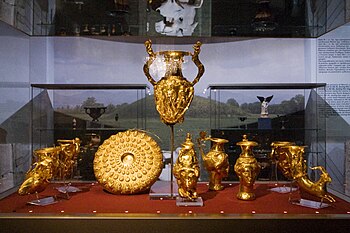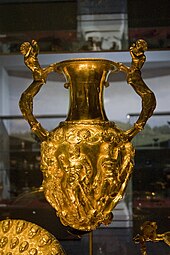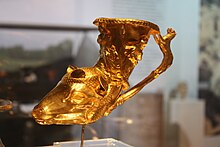Panagyurishte gold treasure
The gold treasure of Panagyurishte is an ancient drinking service, two kilometers south of the December 8, 1949 Panagyurishte in central Bulgaria was discovered.
The gold treasure consists of nine vessels made of pure gold and has a total weight of 6.164 kilograms. The gold vessels belonged to an unknown ruler from the Thracian tribe of the Odrysen and were used for religious ceremonies. It is dated to the end of the 4th century to the beginning of the 3rd century BC. Dated. The gold vessels impress with their artistic workmanship. Art style and decorations show a fusion of Thracian influences.
The treasure belongs to the holdings of the Archaeological Museum in Plovdiv .
Description of the parts
Seven of the nine vessels are rhyta . Three of the Rhyta are in the shape of a woman's head, two resemble a deer head , one resembles a ram's head and one resembles the front part of a billy goat.
The rhyton necks are decorated with scenes from Greek and Thracian mythology.
Amphora - Rhyton
The largest vessel is an amphora .
The handles are formed by two upright, shooting Centaurs . Your rear legs merge into the fluted handle, while the front legs rest on the upper edge of the amphora.
The upper edge of the body is decorated with an egg stick , underneath is a frieze of intertwined palmettes and lotus flowers .
The body of the vessel is taken up by a broad frieze decorated with figures, in the center of which there is a double-winged door flanked by Ionic columns , with lion heads as a capital and winged sphinxes at its base. Seven male figures are lined up around it.
On the right is a bearded man, wrapped in long clothes and leaning on a stick. He prophesies from the liver of a sacrificial animal. The other men are soldiers, naked except for their cloaks thrown on, and armed with swords. One of them has a small beard, a stick in his hand and high shoes and is watching the oracle. Another with a horn gives the signal to attack the gate. Between the closing wings of the gate you can see the heads and hands of an old man hiding. The frieze is separated from the egg-shaped base of the vessel by a palmette line.
On the rounded bottom of the vessel, a Silenus with a double flute and a kantharos as well as the youthful Heracles fighting with the snakes are depicted. On both sides there is a head with Negroid features, the mouths of which are pierced to allow the wine to flow out of the vessel. The body of the vessel has no stand or feet and could not be put down when it was full. People drank from the openings in the negro heads, which is why the amphora is also known as amphora rhyton.
On the inside of the neck of the amphora, the weight is given in Greek letters.
Phials
The phial is made of gold. Around the hemispherical umbo (Latin for shield hump , protruding part of an object) in the center is a border with small rosettes , a wreath of 24 acorns, three friezes with African heads that are getting larger towards the outside - a total of 72 heads. Its value is engraved on the neck of the phiale - 200 and a half drachma and an obolus according to the coin system of the city of Lampsakos . The gold from which the phial is made differs in its composition from the gold from which the rhyta are made.
The heaviest known Thracian gold phial is decorated with four concentric stripes with heads of negroid features and acorns.
Rhyta
1. Rhyton with billy goat protome
The widening opening has an outwardly profiled edge which is decorated with an acorn frieze. Below is a figure frieze: Hera is seated on a throne and holds a phial in her right hand and the edge of a blanket wrapped around her head in her left hand. To the left and right of her are Artemis and Apollon with a bow in their hand, behind them Nike with outspread wings. The names of the gods are engraved near their heads. The lower part of the rhyton merges into the protome (front part of an animal) of a goat with curved horns. The goat's eyes are sculpted. The goat's front legs are stretched forward.
2. Rhyton with deer head
The handle is shaped in the shape of a lion with its front paws resting on the opening of the rhyton. A woman's head is modeled at the base of the handle (at the transition to the vessel). The deer's antlers are shown reduced and foreshortened and completely covered by figural reliefs. Seated Paris in Phrygian clothes holds a shepherd's stick (shepherd's staff?) In his left hand. He raised his right hand to indicate that he had made his choice which of the three goddesses is the most beautiful. The three are placed around him: Hera sits next to him on a throne, Athena sits on the left with sword and helmet. On the other hand, Aphrodite is shown with a radiant face because she won the competition. She wraps her arm around her cloak. Paris is marked with its original name "Alexander". The names of the goddesses are also engraved.
3. Rhyton with deer head
Another rhyton with a deer head, similar to the previous rhyton. Mythological scenes are arranged symmetrically on the frieze: Theseus fighting the Cretan bull in the plain of Marathon , and Heracles with the Kerynite hind .
4. Rhyton with a ram's head
The shape is the same as the rhyton with billy goat protome above. It runs out into the head of a ram. The fur consists of dense rows of engraved, concentric circles. On the frieze of the horns the seated Dionysus is depicted, who holds a scepter in his hand . Next to him is the nymph Eriope. Both names are engraved. On both sides there are dancing maenads with drums and thyrsos .
5. Rhyton in the shape of a woman's head
The vessel opening widens and is bent outwards. A relief of an egg-shaped frieze is shown around the neck of the vessel. The body of the vessel is shaped like a woman's head. The hair is encased in a scarf, which is held by a buckle on the forehead.
6. Rhyton in the shape of a woman's head
7. Rhyton in the shape of a woman's head
The rhyton's body is shaped like a woman's head with a helmet. On the helmet there are two seated eagle griffins as a decoration, in the middle a vegetable ornament. The handle has the shape of a fluted column on which sits a sphinx with spread wings, the front paws of which lie on the edge of the outwardly curved vessel opening. The woman's curly hair looks out from under the helmet and reaches down to her neck, which was damaged when the gold treasure was found and at the lower end of which there is a lion's head with a spout.
As with the other anthropomorphic Rhyton pitchers, the incrustation of the eyes has not been preserved. The female portraits of the three female head fringes are individualized by small differences. The helmet indicates that the woman's head is Athena or an Amazon , while the other two women can be compared to Hera and Aphrodite, who can be seen on the rython with the representation of Paris.
meaning
Similar vessels made of precious metals are symbols of social status and were used in ritual acts by Thracian princes. The depiction of gods and heroes , heads with black African facial features, sacred animals and mythological beings had a ritual function in antiquity - they were supposed to purify the poured liquid and protect those involved in the ritual.
literature
- Dimiter Zontschew: Panagyurishte's gold treasure. Akademie-Verlag, Berlin 1959.
- Ivan Venedikov , Todor Gerassimov: Thracian art. Schroll, Vienna 1973.
- Gold of the Thracians. Archaeological treasures from Bulgaria. Zabern, Mainz, 1979, ISBN 3-8053-0435-8 , pp. 180-188.
- Gavrail Lazov: Panagjurište's Treasure. In: The ancient civilizations of Bulgaria. The gold of the Thracians. Antikenmuseum, Basel 2007, ISBN 978-3-905057-23-2 , pp. 200–206.
Web links
Individual evidence
- ↑ Inventory number 3203. Height 39 cm, diameter 14 cm, weight 1635 grams.
- ↑ Inventory number 3204. Height 3.5 cm, diameter 25 cm, weight 845, 7 grams.
- ↑ Inventory number 3196. Height 14 cm, diameter 9 cm, weight 439.05 grams.
- ↑ Inventory number 3197. Height 13.5 cm, diameter 8.8 cm, weight 674.6 grams.
- ↑ Inventory number 3198. Height 12.5 cm, diameter 8.8 cm, weight 689 grams.
- ↑ Inventory number 3199. Height 12.5 cm, diameter 8.5 cm, weight 505.05 grams.
- ↑ Inventory number 3200. Height 21.5 cm, diameter 10.5 cm, width 13.56 cm, weight 460.75 grams.
- ↑ Inventory number 3201. Height 22.5 cm, diameter 10.3 cm, width 13.56 cm, weight 466, 75 grams.
- ↑ Inventory number 3202. Height 20.5 cm, weight 387.3 grams.





